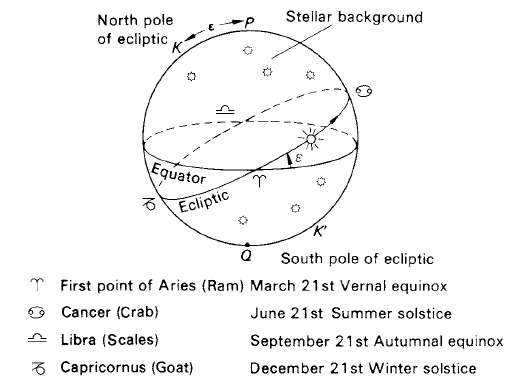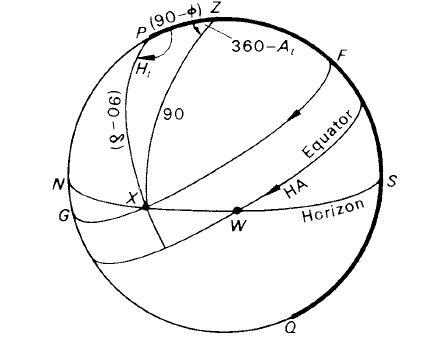
The Sun’s geocentric behaviour
 المؤلف:
A. Roy, D. Clarke
المؤلف:
A. Roy, D. Clarke
 المصدر:
Astronomy - Principles and Practice 4th ed
المصدر:
Astronomy - Principles and Practice 4th ed
 الجزء والصفحة:
p 72
الجزء والصفحة:
p 72
 26-7-2020
26-7-2020
 2501
2501
The Sun’s geocentric behaviour
We have already seen that an observer studying the Sun and stars during a year comes to certain conclusions about the Sun’s behaviour. The Sun appears to revolve about the Earth once per day in company with the stellar background but also has a slower motion with respect to the stellar background, tracing out a yearly path—the ecliptic—among the stars.
More precisely, let us suppose that an observer in a northern latitude (i) measures the meridian zenith distance of the Sun every day, i.e. at apparent noon, and (ii) notes at apparent midnight the constellations of stars that are on the meridian; and that he/she carries out this series of observations for one year. It should be noted that at apparent noon, the Sun’s hour angle has a value zero; at apparent midnight its value is 12h.

Figure 1. The Sun on the meridian.
Then, from the midday measurement of zenith distance, the observer can keep track of the Sun’s declination changes throughout the year. Assuming the latitude ∅ to be known, it can be seen (see figure 1), that if X is the Sun’s position at transit on a particular day,
PA = 90◦ = 90 − ∅ + z + δ
or
δ = ∅ − z
where δ and z are the Sun’s declination and zenith distance respectively. A graph of declination against date is obtained, illustrated in figure 2.

Figure 2. The variation of the Sun’s declination through the year.
The record of those stars appearing on the observer’s meridian at apparent midnight throughout
the year shows that the Sun must make one complete revolution of the stellar background in that time.

Figure 3. The solar path along the ecliptic.
Together with the declination record, it enables the Sun’s yearly path on the stellar background to be
traced out. This path, the ecliptic, is shown in figure 3.
The yearly journey takes the Sun through the twelve houses of the Zodiac, ancient constellations
embodying the stars within a few degrees (8◦–9◦) of the ecliptic. In order, they are given here, with symbols and meanings:

The word ‘Zodiac’ means ‘circle of the animals’ and is the region of the celestial sphere in which the Sun, the Moon and those planets known to the ancients (Mercury, Venus, Mars, Jupiter and Saturn) are found. Because of the effects of precession and as a result of the International Astronomical Union’s (IAU) adoption of constellation boundaries which are not exactly 30◦ long, the Sun’s passage through the constellations does not correspond to its passage through the signs of the Zodiac.
According to the IAU boundary definitions, the Sun travels 44◦ through Virgo, only 7◦ through Scorpius and 18◦ through Ophiuchus, a constellation for which there is no Zodiacal sign. It is, therefore, seen that for half the year the Sun is below the plane of the terrestrial equator and, consequently, that of the celestial equator. Its declination is south during this time, achieving its maximum southerly value about December 21st. This is the time of the winter solstice in the northern hemisphere (and the summer solstice for those people living in the southern hemisphere).
The word ‘solstice’ means ‘the standing still of the Sun’ and refers to the pause in the Sun’s progress in declination. Around March 21st the Sun crosses the equator, its declination changing from south to north. This is the spring equinox (autumnal equinox for southern hemisphere inhabitants). The word ‘equinox’ means ‘equal day and night’ because at the time of occurrence of the vernal and autumnal equinoxes, day and night are equal in length, everywhere on the Earth.

Figure4. The diurnal motion of the Sun.
For six months after March 21st the Sun’s declination is positive, that is northerly, becoming a maximum around June 21st, the date of the summer solstice in the northern hemisphere, thereafter decreasing to zero about September 21st, the autumnal equinox for the northern hemisphere.
The ecliptic, therefore, is a great circle defining a plane that intersects the plane of the celestial equator at an angle of about 23◦ 26'. This angle, usually denoted by ε, is called the obliquity of the ecliptic. The two points of intersection of the ecliptic with the equator are the First Point of Aries,  and Libra,
and Libra,
The zero point, from which right ascension is measured, is �, the point at which the Sun crosses the equator from south to north on its yearly journey round the ecliptic. Right ascension is, therefore,
measured along the equator in the same direction in which the Sun travels round the ecliptic. In one year, consequently, the Sun’s right ascension increases from 0h (March 21st) through 6h (June 21st), 12h (September 21st), 18h (December 21st) to 24h (the succeeding March 21st).
 الاكثر قراءة في مواضيع عامة في علم الفلك
الاكثر قراءة في مواضيع عامة في علم الفلك
 اخر الاخبار
اخر الاخبار
اخبار العتبة العباسية المقدسة


